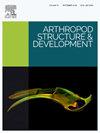鬼蜘蛛(Amaurobioidinae, Anyphaenidae)的交配机制揭示了一种通过功能替代实现的关键生殖器特征的独立回归进化
IF 1.3
3区 农林科学
Q2 ENTOMOLOGY
引用次数: 0
摘要
在进化过程中,动物器官的形态会发生巨大的变化,比如结构的减少或丧失。这种现象在许多蜘蛛的雄性交配器官中反复出现,在某些分类群中,通常发育良好的结构缺失或退化。一个例子是最多样化的蜘蛛谱系,即RTA分支的雄性肢肢的后外侧胫突(RTA)。它经常在生殖器耦合期间执行关键功能,这是生殖器耦合期间的第一个和主要机械接合(即主锁定)。然而,在一些谱系中,RTA要么丢失要么减少,这就提出了生殖偶联是如何在这些分类群中实现的问题,以及RTA回归的潜在驱动因素是什么。为了解决这些问题,我们以麻麻亚科(麻麻科)为模型,研究了9个RTA大小不同的物种的生殖机制。利用冷冻固定交配对的微计算机断层扫描(micro-CT)数据重建生殖器耦合,发现除了RTA突出的物种外,主要锁定仅通过将导体(雄性生殖器硬石)插入雌性交配口之一来实现。我们的系统发育分析表明,RTA在Amaurobioidinae中已经独立丢失或减少了6次,并且在该亚家族中至少发生了一次RTA被导体的功能替代。我们假设使用导体进行主锁定取代了RTA的主要功能,允许其重复回归。本文章由计算机程序翻译,如有差异,请以英文原文为准。

Copulatory mechanics in ghost spiders (Amaurobioidinae, Anyphaenidae) reveals an independent regressive evolution of a key genital trait through functional replacement
During evolution, the morphology of animal organs can vary drastically, such as the reduction or loss of structures. This phenomenon is recurrent in the male copulatory organs of many spiders, where structures that are usually well-developed, are missing or vestigial in some taxa. One example is the retrolateral tibial apophysis (RTA) of the male pedipalp of the most diverse lineage of spiders, the RTA clade. It frequently performs a key function during genital coupling, which is the first and main mechanical engagement during genital coupling (i.e., primary locking). However, in several lineages the RTA is either lost or reduced, raising questions on how genital coupling is achieved in these taxa, and what are the potential drivers for the regression of the RTA. To address these questions, we used the subfamily Amaurobioidinae (Anyphaenidae) as a model and studied the genital mechanics of nine species with different degrees of RTA size. Genital coupling was reconstructed using microcomputed tomography (micro-CT) data of cryofixed mating pairs, revealing that, except for a species with a prominent RTA, primary locking is solely achieved by inserting the conductor (a male genital sclerite) into one of the female copulatory openings. Our phylogenetic analyses indicate that the RTA has been independently lost or reduced six times in Amaurobioidinae, and that at least one functional replacement of the RTA by the conductor has occurred within the subfamily. We hypothesize that the use of the conductor for primary locking replaced the primary function of the RTA, allowing its repeated regressions.
求助全文
通过发布文献求助,成功后即可免费获取论文全文。
去求助
来源期刊
CiteScore
3.50
自引率
10.00%
发文量
54
审稿时长
60 days
期刊介绍:
Arthropod Structure & Development is a Journal of Arthropod Structural Biology, Development, and Functional Morphology; it considers manuscripts that deal with micro- and neuroanatomy, development, biomechanics, organogenesis in particular under comparative and evolutionary aspects but not merely taxonomic papers. The aim of the journal is to publish papers in the areas of functional and comparative anatomy and development, with an emphasis on the role of cellular organization in organ function. The journal will also publish papers on organogenisis, embryonic and postembryonic development, and organ or tissue regeneration and repair. Manuscripts dealing with comparative and evolutionary aspects of microanatomy and development are encouraged.

 求助内容:
求助内容: 应助结果提醒方式:
应助结果提醒方式:


